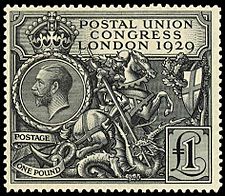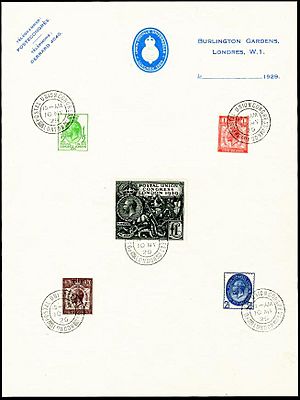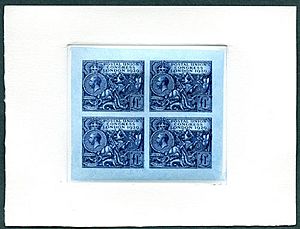Postal Union Congress £1 stamp facts for kids
The Postal Union Congress (PUC) £1 stamp is a famous British postage stamp from 1929. Many people who collect stamps, a hobby called philately, think it's one of the most beautiful British stamps ever made. This stamp was special because it was only the second time Britain had issued a commemorative stamp. These are stamps made to celebrate important events. The first ones were for the British Empire Exhibition in 1924–25.
Quick facts for kids Postal Union Congress £1 stamp |
|
|---|---|

A mint example.
|
|
| Country of production | United Kingdom |
| Date of production | 1929 |
| Designer | Harold Nelson |
| Engraver | J.A.C.Harrison |
| Printer | Bradbury, Wilkinson & Co |
| Commemorates | 1929 Congress of the Universal Postal Union |
| Face value | £1 |
Designing the Stamp
The PUC £1 stamp was designed by an artist named Harold Nelson. It shows a picture of King George V's head. It also features an image of St George and the Dragon. This dragon design was actually an early idea, called an essay, for the 1924 British Empire Exhibition stamps.
A special group was put together to ask for different stamp designs. Out of 16 ideas, the one chosen was approved by Queen Mary. She approved it because King George V was unwell at the time.
Why a £1 Stamp?
This stamp was released with four other stamps to celebrate the 1929 Postal Union Congress. This was a big meeting of the Universal Postal Union, which helps countries work together on mail.
At the time, some people thought the stamp's face value (its price) was too high. The other stamps in the set were much cheaper. People wondered why this one was so expensive.
Some thought the high £1 value was meant to be a special souvenir for the postal delegates visiting the Congress. Others believed it was just a way to get more money from stamp collectors. A famous stamp expert, Stanley Phillips, even called it "Britain’s disgrace." He felt it was wrong to have such a high-value stamp in a set with mostly low-value ones.
How the Stamp Was Made
The PUC £1 stamp was made using a method called line engraving and recess printing. This was done by a company called Bradbury, Wilkinson & Co. They were given the job on one condition: the stamp had to be engraved by J.A.C.Harrison. He was a very skilled engraver.
The stamp also had a special watermark, which is a faint design in the paper. This one showed the letters GVR, which stood for King George V. A total of 61,000 of these stamps were printed. They came in sheets of 20 stamps.
Modern Reproductions
In 2010, the stamp was reproduced for the London 2010 International Stamp Exhibition. A company called Enschede made these new versions using the original die. A die is like a metal plate used to print the stamp design.
To make sure people could tell the new stamps from the old ones, the reproductions had a special design printed on the back. This design looked like a watermark. They also had the word FACSIMILE printed diagonally across the back many times. These new stamps were sold in special packs.
Another printing of the stamp was made in blue at an exhibition in London. Fifty special blocks of four stamps were printed without perforations (the little holes that let you tear stamps apart). These were sold to the public on roughly torn paper.
See also
- List of postage stamps



